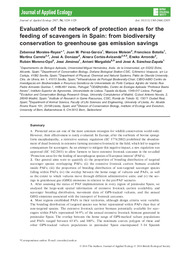Por favor, use este identificador para citar o enlazar este ítem:
https://hdl.handle.net/11000/33889Registro completo de metadatos
| Campo DC | Valor | Lengua/Idioma |
|---|---|---|
| dc.contributor.author | Morales-Reyes, Zebensui | - |
| dc.contributor.author | Perez-García, Juan M. | - |
| dc.contributor.author | Moleón, Marcos | - |
| dc.contributor.author | Botella, Francisco | - |
| dc.contributor.author | Carrete, Martina | - |
| dc.contributor.author | Donázar, José Antonio | - |
| dc.contributor.author | Cortes Avizanda, Ainara | - |
| dc.contributor.author | Arrondo, Eneko | - |
| dc.contributor.author | Moreno-Opo, Ruben | - |
| dc.contributor.author | Jiménez, Jose | - |
| dc.contributor.author | Margalida, Antoni | - |
| dc.contributor.author | Sánchez-Zapata, Jose A | - |
| dc.contributor.other | Departamentos de la UMH::Biología Aplicada | es_ES |
| dc.date.accessioned | 2024-11-18T11:04:29Z | - |
| dc.date.available | 2024-11-18T11:04:29Z | - |
| dc.date.created | 2016-11-07 | - |
| dc.identifier.citation | Journal of Applied Ecology 2017, 54, 1120–1129 | es_ES |
| dc.identifier.issn | 1365-2664 | - |
| dc.identifier.issn | 0021-8901 | - |
| dc.identifier.uri | https://hdl.handle.net/11000/33889 | - |
| dc.description.abstract | 1. Protected areas are one of the most common strategies for wildlife conservation world-wide. However, their effectiveness is rarely evaluated. In Europe, after the outbreak of bovine spongiform encephalopathy, a restrictive sanitary regulation (EC 1774/2002) prohibited the abandonment of dead livestock in extensive farming (extensive livestock) in the field, which led to negative consequences for scavengers. As an attempt to mitigate this negative impact, a new regulation was approved (EC 142/2011) to allow farmers to leave extensive livestock carcasses in the so-called ‘Protection areas for the feeding of necrophagous species of European interest’ (PAFs). 2. Our general aims were to quantify (i) the proportion of breeding distribution of targeted scavenger species overlapping PAFs; (ii) the extensive livestock carrion biomass available inside PAFs; (iii) the proportion of breeding distribution of non-targeted scavenger species falling within PAFs; (iv) the overlap between the home range of vultures and PAFs, as well as the extent to which vultures move through different administrative units; and (v) the savings in greenhouse gas (GHG) emissions in relation to the pre-PAF scenario. 3. After assessing the status of PAF implementation in every region of peninsular Spain, we analysed the large-scale spatial information of extensive livestock carrion availability and scavenger breeding distribution, movement data of GPS-tracked vultures, and the annual GHG emissions associated with the transport of livestock carcasses. 4. Most regions established PAFs in their territories, although design criteria were variable. The breeding distribution of targeted species was better represented within PAFs than that of non-targeted species. The extensive livestock carrion biomass potentially available for scavengers within PAFs represented 34 9% of the annual extensive livestock biomass generated in peninsular Spain. The overlap between the home range of GPS-marked vulture populations and PAFs ranged between 63 4% and 100%. The minimum convex polygon of these and other GPS-tracked vulture populations in peninsular Spain encompassed 3–14 Spanish regions and 1–4 countries. Post-PAF there was a potential reduction of c. 55 7% of GHG emissions compared to pre-PAF. 5. Synthesis and applications. The implementation of the new sanitary regulation by means of areas for the feeding of scavengers could mean an important improvement in scavenger conservation and a noteworthy reduction in greenhouse gas emissions: in Spain, extensive livestock carrion availability might increase to 33 474 t yr1 , and 43 344 t of CO2 eq. might be saved annually. However, we identified some gaps related to the distribution of endangered facultative scavengers. Moreover, given that vultures are highly mobile organisms, the design and management of these feeding areas should be coordinated at both the supra-regional and supra-national scales. | es_ES |
| dc.format | application/pdf | es_ES |
| dc.format.extent | 10 | es_ES |
| dc.language.iso | eng | es_ES |
| dc.publisher | British Ecological Society | es_ES |
| dc.rights | info:eu-repo/semantics/openAccess | es_ES |
| dc.rights.uri | http://creativecommons.org/licenses/by-nc-nd/4.0/ | * |
| dc.subject | carrion availability | es_ES |
| dc.subject | conservation effectiveness | es_ES |
| dc.subject | ecosystem services | es_ES |
| dc.subject | EU sanitary policies | es_ES |
| dc.subject | facultative scavengers | es_ES |
| dc.subject.other | CDU::5 - Ciencias puras y naturales::57 - Biología | es_ES |
| dc.title | Evaluation of the network of protection areas for the feeding of scavengers in Spain: from biodiversity conservation to greenhouse gas emission savings | es_ES |
| dc.type | info:eu-repo/semantics/article | es_ES |
| dc.relation.publisherversion | https://doi.org/10.1111/1365-2664.12833 | es_ES |

Ver/Abrir:
4.pdf
1,5 MB
Adobe PDF
Compartir:
 La licencia se describe como: Atribución-NonComercial-NoDerivada 4.0 Internacional.
La licencia se describe como: Atribución-NonComercial-NoDerivada 4.0 Internacional.
.png)